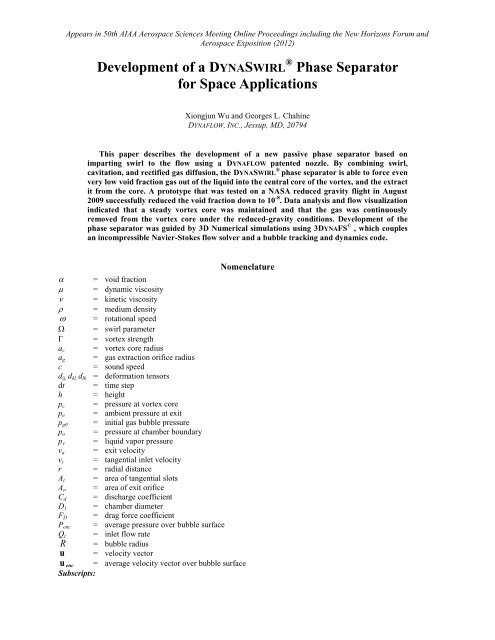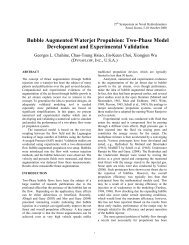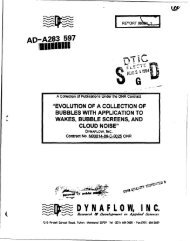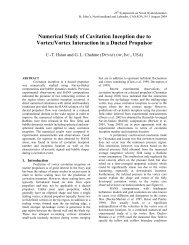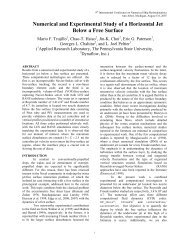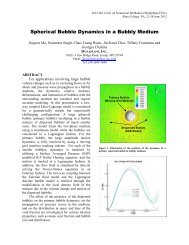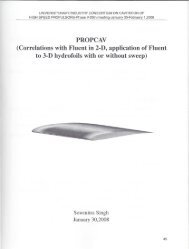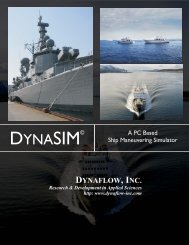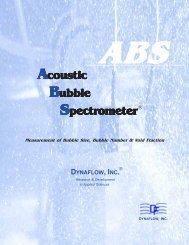Development of a DYNASWIRL - Dynaflow, Inc.
Development of a DYNASWIRL - Dynaflow, Inc.
Development of a DYNASWIRL - Dynaflow, Inc.
You also want an ePaper? Increase the reach of your titles
YUMPU automatically turns print PDFs into web optimized ePapers that Google loves.
Appears in 50th AIAA Aerospace Sciences Meeting Online Proceedings including the New Horizons Forum and<br />
Aerospace Exposition (2012)<br />
<strong>Development</strong> <strong>of</strong> a <strong>DYNASWIRL</strong> ® Phase Separator<br />
for Space Applications<br />
Xiongjun Wu and Georges L. Chahine<br />
DYNAFLOW, INC., Jessup, MD, 20794<br />
This paper describes the development <strong>of</strong> a new passive phase separator based on<br />
imparting swirl to the flow using a DYNAFLOW patented nozzle. By combining swirl,<br />
cavitation, and rectified gas diffusion, the <strong>DYNASWIRL</strong> ® phase separator is able to force even<br />
very low void fraction gas out <strong>of</strong> the liquid into the central core <strong>of</strong> the vortex, and the extract<br />
it from the core. A prototype that was tested on a NASA reduced gravity flight in August<br />
2009 successfully reduced the void fraction down to 10 -8 . Data analysis and flow visualization<br />
indicated that a steady vortex core was maintained and that the gas was continuously<br />
removed from the vortex core under the reduced-gravity conditions. <strong>Development</strong> <strong>of</strong> the<br />
phase separator was guided by 3D Numerical simulations using 3DYNAFS © , which couples<br />
an incompressible Navier-Stokes flow solver and a bubble tracking and dynamics code.<br />
Nomenclature<br />
= void fraction<br />
= dynamic viscosity<br />
= kinetic viscosity<br />
= medium density<br />
= rotational speed<br />
= swirl parameter <br />
= vortex strength <br />
a c = vortex core radius<br />
a g = gas extraction orifice radius<br />
c = sound speed<br />
d ij, d kl, d lk = deformation tensors<br />
dt = time step<br />
h = height<br />
p c = pressure at vortex core<br />
p e = ambient pressure at exit<br />
p g0 = initial gas bubble pressure<br />
p o = pressure at chamber boundary<br />
p v = liquid vapor pressure<br />
v a = exit velocity<br />
v t = tangential inlet velocity<br />
r = radial distance<br />
A t = area <strong>of</strong> tangential slots<br />
A o = area <strong>of</strong> exit orifice<br />
C d = discharge coefficient<br />
D 1 = chamber diameter<br />
F D = drag force coefficient<br />
P enc = average pressure over bubble surface<br />
Q t = inlet flow rate<br />
R = bubble radius<br />
u = velocity vector<br />
u enc = average velocity vector over bubble surface<br />
Subscripts:
g<br />
l<br />
m<br />
= bubble<br />
= gas<br />
= liquid<br />
= mixture<br />
I. Introduction and Background<br />
HE limits on the amount <strong>of</strong> liquids and gases that can be carried to space make it imperative to recycle and<br />
T reuse these fluids. On earth, bubbles in a liquid are easily separable by buoyancy. In microgravity, other<br />
external forces, such as a centrifugal force, must be utilized to separate bubbles from liquids. Two categories <strong>of</strong><br />
centrifugal force separators exist: one uses active rotation by mechanically spinning the tank. This is very efficient<br />
but requires shaft, bearings, and motor. In the second, the tank is fixed, and the rotation is induced by eccentric<br />
injection <strong>of</strong> the mixture. This method requires little power, is much simpler than active separators, and consumes<br />
less energy. McQuillen et al. [1,2] at NASA Glenn Research center has been developing the Cascade Cyclonic<br />
Separation Device (CSD-C) since the mid 90’s. This separator has been proven to be very efficient for mid-range<br />
void fraction (from 50 to 80% <strong>of</strong> gas) with an efficiency approaching 100%. However, it is not as efficient for lower<br />
void fraction, where there is a need for further research [3,4].<br />
A. <strong>DYNASWIRL</strong> ® Vortex Chamber<br />
Under on-going support from NASA, DYNAFLOW INC. has been developing a phase separator for gas-liquid<br />
mixtures based on its efficient swirling flow generation <strong>DYNASWIRL</strong> ® technology. The <strong>DYNASWIRL</strong> ® was<br />
extensively tested for various applications in previous studies and was shown to be able to simultaneously<br />
accomplish several water reclamation functions: liquid<br />
oxidation, TOC reduction, disinfection, and<br />
oxygenation [5-9]. This type <strong>of</strong> vortex generator has<br />
also been extensively used in applications such as algae<br />
removal, underwater painting and surface preparation<br />
[10]. The <strong>DYNASWIRL</strong> ® has also been used to develop a<br />
fine bubble generator [11]. The mechanisms enabling<br />
the accomplishment <strong>of</strong> each <strong>of</strong> these functions are<br />
different while all arise from induced cavitation bubble<br />
dynamics, growth, and collapse.<br />
The phase separation <strong>DYNASWIRL</strong> ® consists <strong>of</strong> two<br />
concentric cylinders as shown in Figure 1. The fluid is<br />
introduced in the space between the two cylinders and<br />
exits through orifices on the cylinder axis, with area,<br />
A o . The swirling flow inside the inner cylinder is<br />
generated with tangential slots which enable flow from<br />
outer to inner cylinder. This configuration makes the<br />
vortex core very stable even at low flow rates. The ratio<br />
between axial and tangential velocities, ,<br />
or the swirl Figure 1. Cross section <strong>of</strong> a <strong>DYNASWIRL</strong> ® Chamber.<br />
parameter, can be controlled by changing the relative<br />
areas <strong>of</strong> the slots, A t , and the orifice, A o , respectively. With high tangential velocities, the pressure on the axis can be<br />
made low enough to make microbubbles grow on the axis and collect into a line vortex bubble. At even higher<br />
tangential velocities cavitation occurs and further enhances gas diffusion and gas transfer into the central vortex<br />
core. The main idea <strong>of</strong> the <strong>DYNASWIRL</strong> ® separator is to use swirl, cavitation, and rectified gas diffusion to force low<br />
void fraction gas out <strong>of</strong> the liquid into the central core <strong>of</strong> the vortex and extract the gas from the central cavitation<br />
core.<br />
The pressure drop at the center <strong>of</strong> a vortex flow is a direct function <strong>of</strong> the vortex strength, Γ, and <strong>of</strong> the radius <strong>of</strong><br />
the vortex viscous core, a c . The flow field <strong>of</strong> a rotating fluid or vortex, can be considered with reasonable accuracy<br />
to be composed <strong>of</strong> two regions. In the innermost region, <strong>of</strong> radius a c , the fluid viscosity is predominant, and the<br />
fluid rotates en masse as a solid body. In that region the tangential velocity <strong>of</strong> the fluid increases linearly with the<br />
distance from the vortex axis where the tangential velocity is zero. At a distance r from the vortex axis the tangential<br />
velocity in this viscous region can be related to the angular velocity, , as<br />
v r<br />
(0)<br />
1<br />
.
In the outermost region <strong>of</strong> the vortex, the flow is that <strong>of</strong> an ideal inviscid fluid. In that region, the circulation,<br />
which is equal to the integral <strong>of</strong> the velocity along a closed line encircling the vortex center, is everywhere constant<br />
and equal to the vortex strength, Γ. The velocity at a point located at a distance r from the vortex center in this<br />
outermost region is related to Γ by<br />
v2 / 2 r.<br />
(1)<br />
At the transition between the viscous and inviscid regions, where r = a c and v 1 = v 2 , the following relationship<br />
can be derived:<br />
2<br />
2 a c<br />
.<br />
(2)<br />
Let p o be the ambient pressure at the inner chamber boundary, the pressure at the vortex center, p c , can be<br />
determined knowing Γ , and the liquid density, ρ. By applying Bernoulli's equation in the inviscid region and<br />
solving the equations <strong>of</strong> conservation <strong>of</strong> mass and momentum in the viscous region one finds:<br />
2<br />
pc po ( / 2 ac<br />
) .<br />
(3)<br />
Cavitation in the vortex occurs when p c drops locally below the liquid critical pressure, p c , or for simility the<br />
vapor pressure, p v , <strong>of</strong> the liquid at the considered temperature [12]. In order to increase the pressure drop or the<br />
degree <strong>of</strong> cavitation it is necessary to either increase Γ or decrease a c . In order to extract the gas from the central<br />
core, the core size has to be larger than the gas extraction orifice size, a g , therefore<br />
2<br />
p p ( / 2 a<br />
) .<br />
(4)<br />
v o g<br />
With <strong>DYNASWIRL</strong> ® , the swirling vortex is generated by tangentially directing fluid about the longitudinal axis <strong>of</strong><br />
a cylindrical swirl chamber positioned within a nozzle. If v t is defined as the fluid tangential injection velocity into<br />
the swirl chamber, and D 1 is the diameter <strong>of</strong> the swirl chamber, Γ is directly related to v t and D 1 by the simple<br />
relation:<br />
Dv<br />
1 t<br />
.<br />
(5)<br />
Since D 1 is a fixed geometric dimension <strong>of</strong> the swirl chamber, v t can be varied and is directly determined by the<br />
total tangential flow rate, Q t and the total tangential injection area, A t with the following relation:<br />
vt Qt / At<br />
.<br />
(6)<br />
The axial velocity component <strong>of</strong> the liquid coming out <strong>of</strong> the orifice has an average value, v a , directly related to<br />
Q t and the area, A o , <strong>of</strong> the exit orifice, by the relation:<br />
va Qt / Ao<br />
.<br />
(7)<br />
Since p o is the driving pressure that push the liquid out <strong>of</strong> the chamber through the axial orifice, it can be written<br />
as<br />
1 2<br />
po pe va<br />
,<br />
(8)<br />
2<br />
where p e is the ambient pressure outside <strong>of</strong> the <strong>DYNASWIRL</strong> ® chamber liquid exit. And Q t and V t can be related by<br />
the relation:<br />
Qt C , d<br />
Ao va (9)<br />
where C d is the discharge coefficient <strong>of</strong> the liquid exit orifice. Combining the above equations, the following<br />
relationship is satisfied:<br />
2<br />
2<br />
Q <br />
t<br />
D1Q<br />
t<br />
Cd A<br />
<br />
<br />
0<br />
ag A <br />
t <br />
1<br />
pv<br />
pe<br />
<br />
2 2<br />
This equation defines what is needed to obtain a stable cavitating core.<br />
B. 3D Coupled Numerical Simulations<br />
Numerical simulations were conducted to to gain insight <strong>of</strong> the separation process and to assist the design <strong>of</strong> an<br />
efficient separator. The bubbly mixture flow inside the swirl chamber was treated from the following two<br />
perspectives:<br />
Microscopic level: Individual bubbles are tracked in a Lagrangian fashion, and their dynamics are followed by<br />
solving the surface averaged pressure Rayleigh-Plesset equation. The bubble responds to its surrounding<br />
medium described by its mixture density, pressure, velocity, etc.<br />
Macroscopic level: Bubbles are considered collectively and define a void fraction space distribution. The<br />
mixture medium has a time and space dependant local density which is related to the local void fraction. The<br />
mixture density is provided by the microscale tracking <strong>of</strong> the bubbles and the determination <strong>of</strong> their local<br />
volume fraction.<br />
(10)
The two levels are fully coupled: the bubble dynamics are in response to the variations <strong>of</strong> the mixture flow field<br />
characteristics, and the flow field depends directly on the bubble density variations. This is achieved through a twoway<br />
coupling between the unsteady Navier Stokes solver 3DYNAFS-VIS © and the bubble dynamics code<br />
3DYNAFS-DSM © .<br />
3DYNAFS-VIS © is an incompressible Navier-Stokes flow solver, it can includes bubbles, cavities, and large free<br />
surface deformation effects and uses moving overset grids and dynamic grid generation schemes. 3DYNAFS-VIS ©<br />
enables direct numerical solution in addition to RANS. The code is based on the artificial-compressibility method.<br />
The mixture medium satisfies the following general continuity and momentum equations:<br />
m<br />
mu m 0 , (11)<br />
t<br />
Dum<br />
2 <br />
m pm 2mij m u m , (12)<br />
Dt<br />
3 <br />
where, the subscript m represents the mixture medium, and <br />
ij<br />
is the Kronecker delta. The mixture density and the<br />
mixture viscosity for a void volume fraction can be expressed as:<br />
<br />
<br />
1 , (13)<br />
m<br />
<br />
<br />
g<br />
1 , (14)<br />
m<br />
where the subscript represents the liquid and the subscript g represents the gaseous bubbles. The medium has a<br />
variable density because the void fraction varies in space and in time.<br />
Lagrangian bubble tracking is accomplished by 3DYNAFS-DSM © . It is a multi-bubble dynamics code for tracking<br />
and describing the dynamics <strong>of</strong> bubble nuclei present in a flow field. The user can select a bubble dynamics model;<br />
either the incompressible Rayleigh-Plesset equation [13] or the compressible Keller-Herring equation [14-16]. In the<br />
first option, the bubble dynamics is solved by using a modified Rayleigh-Plesset equation improved with a Surface-<br />
Averaged Pressure (SAP) scheme:<br />
3k<br />
2<br />
3 | |<br />
2 1 R0<br />
2<br />
4mR uenc<br />
ub<br />
RR R pv pg 0<br />
Penc<br />
,<br />
2 <br />
<br />
m<br />
R<br />
<br />
(15)<br />
R R <br />
<br />
<br />
4<br />
where R is the bubble radius at time t, R 0 is the initial or reference bubble radius, is the surface tension parameter,<br />
µ m is the medium viscosity, m is the density, p v is the liquid vapor pressure, p g0 is the initial gas pressure inside the<br />
bubble, k is the polytropic compression law constant, u enc is the liquid convection velocity vector and u b is the<br />
bubble travel velocity vector, and P enc is the ambient pressure “seen” by the bubble during its travel. With the<br />
Surface Averaged Pressure (SAP) model, P enc and u enc are the average <strong>of</strong> the pressure over the surface <strong>of</strong> the bubble.<br />
If the second option is adopted, the effect <strong>of</strong> liquid compressibility is accounted for by using the following<br />
Keller-Herring equation.<br />
3k<br />
2<br />
R 3 R <br />
2 1 R R d <br />
R0<br />
2<br />
4 mR<br />
| uenc ub<br />
|<br />
1 RR 1 R 1 pv pg 0<br />
Penc<br />
,<br />
cm 2 3cm <br />
m<br />
cm cm<br />
dt<br />
<br />
R<br />
<br />
(16)<br />
<br />
R R <br />
<br />
4<br />
where c m is the speed <strong>of</strong> sound in the mixture medium.<br />
The bubble trajectory is obtained from the bubble motion equation derived by Johnson and Hsieh [17]:<br />
1/2<br />
du<br />
( )<br />
b<br />
m 3R<br />
m u<br />
1 m du<br />
dub<br />
<br />
b m Kv mdij<br />
FD u ub u ub ub g 1/4<br />
<br />
b .<br />
dt 2R x 2 <br />
<br />
dt dt<br />
<br />
u u (17)<br />
R( d d )<br />
b b b b b<br />
The first term in Equation (17) accounts for the drag force effect on the bubble trajectory. The drag coefficient<br />
F D is determined by the empirical equation <strong>of</strong> Haberman and Morton [18]. The second and third term in Equation<br />
(17) account for the effect <strong>of</strong> change in added mass on the bubble trajectory. The fourth term accounts for the effect<br />
<strong>of</strong> pressure gradient, and the fifth term accounts for the effect <strong>of</strong> gravity. The last term in Equation (17) is the<br />
Saffman [19] lift force due to shear as generalized by Li & Ahmadi [20]. The coefficient K is 2.594, is the<br />
kinematic viscosity, and d ij is the deformation tensor.<br />
The unsteady two-way interactions can be described as follows:<br />
<br />
The bubbles in the flow field are influenced by the local densities, velocities, pressures, and pressure gradients<br />
<strong>of</strong> the mixture medium. The dynamics <strong>of</strong> individual bubbles and Lagrangian tracking <strong>of</strong> them are based on<br />
these local flow variables as described in Equations (15) to (17).<br />
g<br />
lk<br />
kl
The mixture flow field is influenced by the presence <strong>of</strong> the bubbles. The local void fraction, and accordingly<br />
the local mixture density, is modified by the migration and size change <strong>of</strong> the bubbles, i.e., the bubble<br />
population and size. The flow field is adjusted according to the modified mixture density distribution in such a<br />
way that the continuity and momentum are conserved through Equations (11) and (12).<br />
Void fractions based on -cells were used in the 3-D space to compute the void fraction [21].<br />
II. Reduced Gravity Flight Test<br />
A prototype <strong>of</strong> the <strong>DYNASWIRL</strong> ® Free Vortex Phase Separator (FVS) was selected to be tested at a reduced<br />
gravity flight test under the NASA FAST program (The Facilitated Access to the Space Environment for<br />
Technology <strong>Development</strong> and Training) in August, 2009. This prototype consisted <strong>of</strong> 3 chambers connected in<br />
series as shown in Figure 2. In the center was the <strong>DYNASWIRL</strong> ® chamber where the gas-liquid mixture was<br />
introduced in the space between the two cylinders. The side chambers were a vacuum chamber and a mixing<br />
chamber. An orifice between the vacuum chamber and the <strong>DYNASWIRL</strong> ® chamber acted as a “gas finder” orifice.<br />
Once the core was generated in the vortex chamber, the “gas finder” orifice started to extract gas from the vortex<br />
core into the vacuum chamber. This chamber was connected to a vacuum pump to insure gas removal at a faster<br />
speed. The “mixing” chamber was also connected to the “vortex” chamber, but through a larger orifice. It was used<br />
to receive a gas-liquid mixture obtained with a <strong>DYNASWIRL</strong> ® bubble generator before the test. During the test it was<br />
used as a reservoir to collect the gas reduced mixture (which exited from the larger orifice <strong>of</strong> the “vortex” chamber).<br />
This mixture <strong>of</strong> gas and liquid was then pumped back to the “vortex” chamber for further gas-liquid separation.<br />
Figure 2. Schematic <strong>of</strong> the prototype <strong>of</strong> the <strong>DYNASWIRL</strong> ® Phase Separator, which was tested at a reduced<br />
gravity flight test under the NASA FAST program in August, 2009.<br />
A. Experiment Setup<br />
The <strong>DYNASWIRL</strong> ® phase separator prototype was setup for the reduced gravity flight test in a loop sketched in<br />
Figure 3. A ¾ HP centrifugal pump was used to supply the mixture to the phase separator and a vacuum/air supply<br />
pump was used to provide vacuum during the phase separation process. A vacuum breaker was installed at the gas<br />
extraction port <strong>of</strong> the vacuum chamber to prevent liquid from getting into the gas extaction line. Additionally, a<br />
“liquid catcher” chamber was installed to store the water escaped from the vacuum chamber under microgravity<br />
when vacuum was applied to prevent the water from entering the vacuum pump. This water from the liquid catcher<br />
chamber was recycled back into the FVS periodically.<br />
An ABS ACOUSTIC BUBBLE SPECTROMETER ®© [22-26] with two hydrophones setup in the mixing chamber was<br />
used to monitor the void fraction during the whole flight. A high definition video camera was also used for flow<br />
visualization <strong>of</strong> the gas extraction process. In addition, the pressures in all the three chambers, as well as the<br />
accelerometer signals from the airplane, were recorded during the flight. The entire setup had a secondary<br />
confinement to prevent any possible leaks during the reduced gravity flight. The <strong>DYNASWIRL</strong> ® phase separator was<br />
confined in a Plexiglas box and all pipes were equipped with a secondary hose to capture any potential leaks. Table<br />
1 shows a list <strong>of</strong> the components used in the experiment setup as shown in Figure 3.
Figure 3. Experimental setup for the bubble generation and air separation experiments conducted in a<br />
reduced gravity flight test under FAST program in August, 2009.<br />
Item<br />
Description<br />
Dimensions<br />
(in)<br />
Weight<br />
(lbs)<br />
Pump Water pump, 3/4HP, 115V, 9 Amps. 1789 41<br />
FVS <strong>DYNASWIRL</strong> ® Chamber: Free Vortex Separator 181010 25<br />
Vacuum/ Air<br />
Pump<br />
Vacuum/air pump, 115V, 4.2 Amps 8611 16<br />
Bubble<br />
Generator<br />
<strong>DYNASWIRL</strong> ® Bubble Generator 611 1<br />
Laptop Dell Inspiron laptop 14101.5 6<br />
ABS ABS ACOUSTIC BUBBLE SPECTROMETER® box 168.52 3<br />
Frame<br />
Aluminum tubing frame with aluminum bottom and<br />
top<br />
483620 46<br />
Camcorder HD digital camcorder 2<br />
Misc. PVC piping, valves, tubing, water… - ~115<br />
Table 1. List <strong>of</strong> Equipment used in the Free Vortex Separator Experiment on the reduced gravity flight<br />
test under the FAST program in August, 2009.<br />
B. Numerical Simulations<br />
3DYNAFS-VIS © was used to characterize the <strong>DYNASWIRL</strong> ® phase separator prototype. A multi-block grid, as<br />
shown in Figure 4, was generated to represent the <strong>DYNASWIRL</strong> ® chamber with two orifices connecting to the two<br />
external chambers. A larger orifice connected with the mixing chamber and a smaller one connected with the<br />
vacuum chamber. Figure 5 shows a sample pressure distribution at an inlet flow rate <strong>of</strong> 20 GPM, the pressure was<br />
normalized with the high pressure at the injection slot <strong>of</strong> the inner <strong>DYNASWIRL</strong> ® chamber. A low pressure vortex<br />
core region can be clearly observed in the swirl chamber from Figure 5.<br />
The flow field in the phase separator was unsteady<br />
and the flow near the two orifices behaved quite<br />
differently from each other. Figure 6 and Figure 7 show<br />
some details <strong>of</strong> the flow field at two time steps near the<br />
liquid extraction and gas extracton orifices respectively.<br />
Figure 4. Multi-block grid used for 3DYNAFS-<br />
VIS © simulation <strong>of</strong> the <strong>DYNASWIRL</strong> ® phase
Animation with time show more significant fluctuations near the smaller orifice, where the flow can come in and<br />
out <strong>of</strong> the swirl chamber through the orifice. 3D coupled numerical simulations on the <strong>DYNASWIRL</strong> © phase separator<br />
by coupling 3DYNAFS-VIS © and 3DYNAFS-DSM © were also performed to study the bubble dynamics in the flow<br />
field. Figure 8 shows a snapshot <strong>of</strong> the bubbles in the flow field obtained from the coupled run. Bubbles were<br />
injected from the slot <strong>of</strong> the <strong>DYNASWIRL</strong> © inner chamver, as shown in the figure, bubbles were concentrated into the<br />
vortex core region and escaped into the vacuum chamber through the gas extraction orifice.<br />
Figure 5. Normalized pressure distribution in the <strong>DYNASWIRL</strong> ® phase separatorat flow rate <strong>of</strong> 8.5 GPM.<br />
SC<br />
MC<br />
SC<br />
MC<br />
Figure 6. Flow field near the larger orifice that connects swirl chamber (VC) and mixing chamber (MC) at<br />
two different time steps.<br />
VC<br />
SC<br />
VC<br />
SC<br />
Figure 7. Flow field near the smaller orifice that connects vacuum chamber (VC) and swirl chamber (SC) at<br />
two different time steps
Figure 8. A snapshot <strong>of</strong> the results from 3DYNAFS-DSM © using background flow provided by 3DYNAFS-VIS © .<br />
C. Flight Test Results<br />
The reduced gravity test was performed in a Zero-<br />
G Boeing 727 airplane on August 12, 2009. The<br />
bubbly medium was generated before the parabolic<br />
maneuvers started. Once the void fraction reached a<br />
preset 1% value, the bubble generator was turned <strong>of</strong>f<br />
and the bubbly medium were kept circulating<br />
throught the mxing chamber without going through<br />
the <strong>DYNASWIRL</strong> ® chamber to maintain a<br />
homogeneous bubbly medium until right before the<br />
parabolic maneuvers began. Then the bubbly medium<br />
was directed into the phase separator to remove the<br />
injected air, the phase separation process was<br />
monitored during the complete flight duration with<br />
parabolic maneuvers.<br />
The total flight time during which there were<br />
parabolic maneuvers was about 55 minutes. The<br />
<strong>DYNASWIRL</strong> ® phase separator was run at a flow rate<br />
<strong>of</strong> 15 GPM for the first 25 minutes for initial gas<br />
extraction, and then at an increased flow rate <strong>of</strong> 20<br />
GPM for the final gas extraction. Data analysis and<br />
flow visualizations indicated that a steady vortex core<br />
was maintained and that the gas was continuously<br />
removed from the vortex core during the zero-gravity<br />
condition.<br />
Figure 9 shows the gas bubbles being extracted<br />
from the vortex core under zero-gravity. As the gas<br />
extraction progressed, the vortex core shrunk and the<br />
number <strong>of</strong> visible bubbles kept decreasing. It was also<br />
observed during the test that the bubbles in the vortex<br />
chamber moved towards the core as shown in Figure<br />
10.<br />
Figure 11 shows the images <strong>of</strong> the mixing<br />
chamber taken during the initial and the final stages<br />
<strong>of</strong> the flight. As seen from these images clarity was<br />
much improved at the end as the visible amount <strong>of</strong><br />
bubbles significantly reduced.<br />
Similar results were observed from the images <strong>of</strong><br />
the vortex chamber and the vacuum chamber during<br />
the initial and final stages <strong>of</strong> the test. These images are<br />
shown in Figure 12. The number <strong>of</strong> visible bubbles<br />
Figure 9. Gas extraction under zero gravity.<br />
Vacuum Chamber<br />
Vortex Chamber<br />
Vortex Core<br />
Figure 10. bubbles in the vortex chamber moving<br />
towards the vortex core.<br />
Figure 11. Sanp shots <strong>of</strong> the mixing chamber during<br />
the initial (left) and final (right) stages <strong>of</strong> the flight.
was significantly reduced in the final stages <strong>of</strong> the flight when compared to the initial stages. These images also<br />
show that vortex core size had shrunk in the final stage when compared to that at initial stage.<br />
Figure 12. Snap shots <strong>of</strong> the vortex chamber and the vacuum chamber during the initial stage (left) and final<br />
stage (right) <strong>of</strong> the reduced gravity flight.<br />
Figure 14. Sample signals <strong>of</strong> the Pressure<br />
signal and gravity in the z-direction during<br />
the flight.<br />
Figure 13. Void fraction as a function <strong>of</strong> time.<br />
Figure 15. Comparisons <strong>of</strong> test raw signals (red ) measured by the hydrophones during the initial stage <strong>of</strong> the<br />
flight, i.e high void fraction (left) and final stage <strong>of</strong> the flight, i.e. low void fraction (right).<br />
Figure 14 shows the pressure signal amplitudes in the mixing, vacuum, and vortex chambers along with the<br />
acceleration <strong>of</strong> gravity in the z direction on the second y axis. As seen in the figure, the pressure was highest in the<br />
vortex chamber and lowest in the vacuum chamber. Since the vacuum pump was turned <strong>of</strong>f to avoid water fouling<br />
the vacuum line during the reduced gravity phases, under the microgravity condition the pressure in all three<br />
chambers was higher, compared to the case when there was gravity present, however this change had no effects on<br />
the smooth operation <strong>of</strong> the phase separator.
Figure 13 shows the void fraction in the mixing chamber during the flight as measured by the ABS . Note that<br />
the hydrophones deployed in this test were designed to measure only very low void fractions. In the initial stage, the<br />
void faction was above the upper limit <strong>of</strong> the measurement range, the reading was saturated at around 2 x 10 -5 . As<br />
the phase separation progressed, the void fraction decreased continuously with time, proving that the <strong>DYNASWIRL</strong> ®<br />
phase separator was working under microgravity. At the end <strong>of</strong> the test, the void fraction measured by the ABS was<br />
<strong>of</strong> the order <strong>of</strong> 10 -8 , while is started at the beginning <strong>of</strong> the flight over 10 -2 . Figure 15 shows a comparison <strong>of</strong> a<br />
sample ABS raw signals at the initial and final stage, the received test signals are in red. At the beginning, the<br />
received signals were very weak due to the large amount <strong>of</strong> bubbles. With the <strong>DYNASWIRL</strong> ® phase separator<br />
continuously removing bubbles, the void fraction decreased, and the received test signals became very significantly<br />
stronger.<br />
From the above described reduced gravity test results, identified areas for improvement included:<br />
Improve gas extraction efficiency.<br />
Reduce or eliminate the remixing <strong>of</strong> liquid and gas<br />
Expand the operation ranges <strong>of</strong> void fraction and flow rate<br />
Enable a continuous feed <strong>of</strong> two-phase content<br />
We are addressing these identified areas for improvement through ground based tests and numerical simulations<br />
prior to the next scheduled zero gravity flight tests in 2012.<br />
III. Conclusion<br />
A new phase separator based on DYNAFLOW patented <strong>DYNASWIRL</strong> ® technology was developed and tested during<br />
a NASA reduced gravity flight. During the test, the phase separator successfully reduced the mixture void fraction<br />
down to 10 -8 . Data analysis and flow visualization indicated that a steady vortex core was maintained and that the<br />
gas was continuously removed from the vortex core under the reduced-gravity conditions. 3D Numerical simulations<br />
using a Navier-Stokes flow solver, 3DYNAFS-VIS © , coupled with a bubble dynamics solver, 3DYNAFS-DSM © were<br />
used to guide the design. 3DYNAFS © provided us with a powerful numerical tool to help optimize the design and<br />
ultimately develop a fully operational <strong>DYNASWIRL</strong> ® Phase Separator to be tested by NASA on the International<br />
Space Station (ISS).<br />
Acknowledgments<br />
This work is supported by NASA under Grant No. NNX09AI35G, the authors would like to thank Mr.<br />
McQuillen, program monitor, for his support and advice.<br />
References<br />
1 McQuillen, J. B., Neumann, E. S., “Two-Phase Flow Research Using the Laserjet Apparatus,” NASA Technical<br />
Memorandum, NASA, Cleveland, OH 106814, 1995, pp. 1-14.<br />
2 Hoyt, N. C., Kamotani, Y., McQuilen, J. B., Sankovics, J. M., “Computational Investigation <strong>of</strong> the NASA Cascade Cyclonic<br />
Separation Device,” 46 th AIAA Aerospace Sciences Meeting and Exhibit, Reno, Nevada, 2008.<br />
3 Shoemaker, J. M., Schrage, D. S., “Microgravity Fluid Separation Physics – Experimental and Analytical Results,” 35 th AIAA<br />
Aerospace Sciences Meeting and Exhibit, Reno, Nevada, 1997.<br />
4 Schrage, D. S., Shoemaker, J. M., McQuillen, J., “Passove Two-phase Fluid Separation – A Dynamic Simulation Model,”<br />
36 th AIAA Aerospace Sciences Meeting and Exhibit, Reno, Nevada, 1998.<br />
5 Chahine, G. L., Hsiao, C. T., Choi, J. K., Kalumuck, K. M., Loraine, G., Aley, P. D., Frederick, G. S., “<strong>Development</strong> <strong>of</strong> a<br />
DYNAJETS Cavitation System for High Rate Disinfection <strong>of</strong> Combined Sewer Overflows,” DYNAFLOW, INC, Report 2M3032-1,<br />
2005.<br />
6 Chahine, G. L., Kalumuck, K. M., Hsiao, C. T., Choi, J. K., Loraine, G., Aley, P. D., Frederick, G. S., “Water Reclamation<br />
Using the DYNAJETS Cavitating Jets for the Advanced Life Support System,” DYNAFLOW, INC, Report 2M2001-1-NASA,2005.<br />
7 Loraine, G., Chahine, G. L., Hsiao, T. T., Choi, J. K., Jain, A., Aley, P. D., Frederick, G. S., “ Cavitating Jets for Aquaculture<br />
Wastewater Treatment and Recycling,” DYNAFLOW, INC, Report 2M5016-NOAA-01, 2005.<br />
8 Chahine, G. L., Hsiao, C. T., Choi, J. K., Loraine, G., Frederick, G. S., Aley, P. D., “Reduction <strong>of</strong> Chemical and Biological<br />
Containments Using the DYNAJETS Cavitating Jets: Post-or Pre treatment for Desalination,” DYNAFLOW, INC, Report 2M3038-1-<br />
ONR, 2005.<br />
9 Loraine, G., Choi, J. K., “Seawater Remediation Technology Using DynaJets,” DYNAFLOW, INC, Report 2M6022-1-<br />
NSWC,2007.<br />
10 Chahine, G. L., Choi, J. K., Loraine, G., Aley, P., “<strong>Development</strong> <strong>of</strong> a <strong>DYNASWIRL</strong> Cavitating Jet Nozzle for Underwater<br />
Hull Grooming” DYNAFLOW, INC, Report 2M7036-NSWCCD-1,2009.<br />
11 Chahine, G. L., Barbier, C., Loraine, G., Choi, J. K., "<strong>Development</strong> <strong>of</strong> a Bubble Generator Suitable for Spallation Neutron<br />
Source Shock Mitigation Applications", DYNAFLOW, INC, Report 2M7022-DOE-Bub-1, May 2008.
12 Chahine, G. L., “A Numerical Model for Three-Dimensional Bubble Dynamics in Complex Geometries”, 22nd American<br />
Towing Tank Conference, St. Johns, Newfoundland, Canada, August 1989.<br />
13 Plesset, M. S., “Dynamics <strong>of</strong> Cavitation Bubbles”, Journal <strong>of</strong> Applied Mechanics, Vol. 16, 1948, pp. 228-231.<br />
14 Gilmore, F. R., “The Collapse and Growth <strong>of</strong> a Spherical Bubble in a Viscous Compressible Liquid”, Div. Rep. 26-4,<br />
California Institute <strong>of</strong> Technology Hydrodynamics Laboratory, Pasadena, CA, 1952.<br />
15 Knapp, R. T., Daily, J. W., Hammit, F. G., “Cavitation”, McGraw-Hill, New York, 1970.<br />
16 Vokurka, K., “Comparison <strong>of</strong> Rayleigh’s, Herring’s, and Gilmore’s Models <strong>of</strong> Gas Bubbles”, Acustica, Vol. 59, No. 3, 1986,<br />
pp. 214-219.<br />
17 Johnson, V. E. and Hsieh, T., “The Influence <strong>of</strong> the Trajectories <strong>of</strong> Gas Nuclei on Cavitation <strong>Inc</strong>eption”, Proc. Sixth<br />
Symposium on Naval Hydrodynamics, Washington, DC, 1966, pp. 163-179.<br />
18 Haberman, W. L. and Morton, R. K., “An Experimental Investigation <strong>of</strong> the Drag and Shape <strong>of</strong> Air Bubbles Rising in<br />
Various Liquids”, Report 802, David Taylor Model Basin, Washington, DC, 1953.<br />
19 Saffman, P. G., “The Lift on a Small Sphere in a Slow Shear Flow”, Journal <strong>of</strong> Fluid Mechanics, Vol. 22, 1965, pp. 385-400.<br />
20 Li, A. and Ahmadi, G., “Dispersion and Deposition <strong>of</strong> Spherical Particles from Point Sources in a Turbulent Channel Flow”,<br />
Aerosol Science and Technology, Vol. 16, 1992, pp. 209-226.<br />
21 Chahine, G. L., Hsiao, C. T., Choi, J. K., Wu, X., “Bubble Augmented Waterjet Propulsion: Two-Phase Model <strong>Development</strong><br />
and Experimental Validation”, 27th Symposium on Naval Hydrodynamics, Seoul, Korea, October, 2008.<br />
22 Duraiswami, R., Prabhukumar, S., Chahine, G. L., "Bubble Counting Using an Inverse acoustic Scattering Method",<br />
Journal <strong>of</strong> Acoustical. Society <strong>of</strong> America, 104 (5), November 1998, pp.2699-2717.<br />
23 Chahine, G. L., Kalumuck, K. M., Cheng, J. Y., Frederick, G. S., “Validation <strong>of</strong> Bubble Distribution Measurements <strong>of</strong> the<br />
ABS Acoustic Bubble Spectrometer with High Speed Video Photography,” 4th International Symposium on Cavitation,<br />
California Institute <strong>of</strong> Technology, Pasadena, California, June 2001.<br />
24 Chahine, G. L. and Kalumuck, K.M., “<strong>Development</strong> <strong>of</strong> Near Real Time Instrument for Nuclei Measurements: The ABS<br />
ACOUSTIC BUBBLE SPECTROMETER ®© ,” 4th Joint ASME-JSME Joint Fluids Engineering Conference, Honolulu, HI, July 2003.<br />
25 Chahine, G. L., Hsiao, C. T., Tanguay, M., Loraine, G., “Acoustic Measurements <strong>of</strong> Bubbles in Biological Tissue,”<br />
Cavitation: Turbo-machinery & Medical Applications, WIMRC Forum, Warwick University, U.K, July 2008.<br />
26 Wu X. and Chahine, G. L., “<strong>Development</strong> <strong>of</strong> an Acoustic Instrument for Bubble Size Distribution Measurement”, Journal <strong>of</strong><br />
Hydrodynamics, Ser. B, Vol. 22, Issue 5, Supplement 1, October 2010, PP. 330 – 336.


